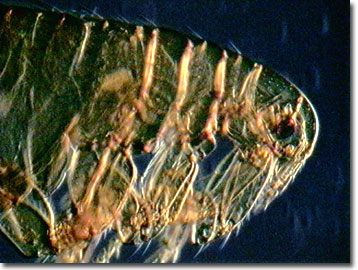Darkfield Digital Image Gallery
Human Flea (Pulex irritans)
The human flea (Pulex irritans) is one of more than 1,600 species and subspecies of flea that populate the Earth from the Arctic Circle to the deserts of Africa. Fleas, members of the insect order Siphonaptera, parasitize mammals and birds for their blood, using specialized anatomical structures to attach to the hosts' skin.

As its name suggests, the preferred food for P. irritans is human blood, but it will feed on other mammals as well. Historically, humans have had ongoing infestations of Pulex and they still occur in some population groups. Infestations of human fleas are less of a problem in societies where personal hygiene dictates frequent bathing and adequate clothes laundering.
The human flea is not the primary species responsible for transmitting the bubonic plague throughout Europe during the Middle Ages (that dubious honor belongs to the rodent flea), although it is capable of spreading it. One disease that Pulex is known to transmit is murine typhus, a mild form of typhus caused by the bacterium Rickettsia typhi. Feeding on a human who has the disease infects the flea. The bacteria grow in the epithelial cells lining the flea's gut wall and are excreted in the insect's feces. The infection kills the flea after 12 to 18 days. Scratching a fleabite infects a person as the rubbing spreads the flea's infected feces into the wound. After an incubation period of one to two weeks, an infected person experiences headaches, loss of appetite, malaise and a rapid rise in temperature with fever, chills, marked prostration and nausea. Four to six days later, a rash appears over most of the body. Aside from the possibility of transmitting this disease, the human flea's saliva contains enzymes and histamine-like substances, which cause allergic reactions in some of their victims.
The flea's life cycle consists of four stages: egg, larva, pupa and adult. Eggs are laid on the body of the host animal, but since they aren't sticky, they can drop in any number of places. The larva resembles a small legless caterpillar and it feeds on dried excrement, dried bits of skin, dead mites, dried blood, and other organic debris. Fecal matter from the parent flea is essential to the successful metamorphosis of some species of flea larvae. During this larval development period the parent flea consumes a great deal of blood, up to 30 times its own weight, to produce a large quantity of feces for its larvae. After three molts, the larvae spin silk cocoons that initiate the pupal stage. The pupae emerge as adults days, weeks, or even months later. When conditions are unfavorable, a cocooned flea can remain dormant for up to a year, waiting for warm-blooded prey. At any given time, only five percent of living fleas are in adult form, while most are distributed in the egg, larva, or pupa stages. The life span of adult fleas varies from several weeks to over a year.
Contributing Authors
Cynthia D. Kelly, Thomas J. Fellers and Michael W. Davidson - National High Magnetic Field Laboratory, 1800 East Paul Dirac Dr., The Florida State University, Tallahassee, Florida, 32310.
BACK TO THE DARKFIELD IMAGE GALLERY
BACK TO THE DIGITAL IMAGE GALLERIES
Questions or comments? Send us an email.
© 1995-2025 by Michael W. Davidson and The Florida State University. All Rights Reserved. No images, graphics, software, scripts, or applets may be reproduced or used in any manner without permission from the copyright holders. Use of this website means you agree to all of the Legal Terms and Conditions set forth by the owners.
This website is maintained by our
Graphics & Web Programming Team
in collaboration with Optical Microscopy at the
National High Magnetic Field Laboratory.
Last Modification Friday, Nov 13, 2015 at 01:19 PM
Access Count Since September 17, 2002: 18760
Visit the website of our partner in introductory microscopy education:
|
|
